Real-Time Monitoring of Cement Paste Carbonation with In Situ Optical Fiber Sensors
Abstract
1. Introduction
2. Materials and Methods
2.1. Carbonation Depth-Monitoring
- Set C1 injections are used to access combined responses from the inner and outer CO2 optical fiber sensors when the carbonation depth has not reached the inner cavity. The pressure in the mixing container is always raised to 4 bars, regardless of the concentration of CO2, and its contents are slowly vacated over a couple of minutes into the carbonation container.
- Set C2 consists of long-lasting injections of 100% CO2, with the goal of increasing the carbonation rate, ensuring that the carbonation depth reaches the inner cavity. Injection duration varies between 22 and 52 min.
- Set C3 is made of 100% CO2 injections, aimed at accessing the combined response of the sensors once the carbonation depth reaches the inner cavity.
2.2. Total Carbonation-Monitoring
3. Results
3.1. Carbonation Depth-Monitoring
3.2. Total Carbonation-Monitoring
4. Conclusions
Author Contributions
Funding
Institutional Review Board Statement
Informed Consent Statement
Data Availability Statement
Conflicts of Interest
References
- Aïtcin, P.-C. Cements of Yesterday and Today. Cem. Concr. Res. 2000, 30, 1349–1359. [Google Scholar] [CrossRef]
- de Brito, J.; Kurda, R. The Past and Future of Sustainable Concrete: A Critical Review and New Strategies on Cement-Based Materials. J. Clean. Prod. 2021, 281, 123558. [Google Scholar] [CrossRef]
- Wray, P. Straight Talk with Karen Scrivener on Cements, CO2 and Sustainable Development. Am. Ceram. Soc. Bull. 2012, 91, 47–50. [Google Scholar]
- van Oss, H.G. Background Facts and Issues Concerning Cement and Cement Data; United States Geological Survey: Reston, VA, USA, 2012.
- International Energy Agency. Global Cement Production, 2010–2019. Available online: https://www.iea.org/data-and-statistics/charts/global-cement-production-2010-2019 (accessed on 2 June 2023).
- Fernandez, A.; Leung, Y. Low-Carbon Transition in the Cement Industry; International Energy Agency: Paris, France, 2018; Available online: https://www.iea.org/reports/technology-roadmap-low-carbon-transition-in-the-cement-industry (accessed on 2 June 2023).
- Schneider, M. The Cement Industry on the Way to a Low-Carbon Future. Cem. Concr. Res. 2019, 124, 105792. [Google Scholar] [CrossRef]
- York, I.N.; Europe, I. Concrete Needs to Lose Its Colossal Carbon Footprint. Nature 2021, 597, 593–594. [Google Scholar] [CrossRef]
- Watts, J. Concrete: The Most Destructive Material on Earth. Guardian. 25 February 2019. Available online: https://www.theguardian.com/cities/2019/feb/25/concrete-the-most-destructive-material-on-earth (accessed on 2 June 2023).
- Darraj, N.; Bender, G. Carbon Neutral Energy Intensive Industries; UNECE: Geneva, Switzerland, 2022; Available online: https://unece.org/sustainable-energy/cleaner-electricity-systems/carbon-neutral-energy-intensive-industries (accessed on 2 June 2023).
- Pacheco-Torgal, F.; Melchers, R.E.; Shi, X.; De Belie, N.; Van Tittelboom, K.; Sáez, A. Eco-Efficient Repair and Rehabilitation of Concrete Infrastructures; Woodhead Publishing: Sawston, UK, 2017; ISBN 9780081021828. [Google Scholar]
- Šavija, B.; Luković, M. Carbonation of Cement Paste: Understanding, Challenges, and Opportunities. Constr. Build. Mater. 2016, 117, 285–301. [Google Scholar] [CrossRef]
- Taheri, S. A Review on Five Key Sensors for Monitoring of Concrete Structures. Constr. Build. Mater. 2019, 204, 492–509. [Google Scholar] [CrossRef]
- Mehta, P.K.; Monteiro, P.J.M. Concrete: Microstructure, Properties, and Materials, 4th ed.; McGraw-Hill Education: New York, NY, USA, 2014; ISBN 9780071797870. [Google Scholar]
- Behnood, A.; Van Tittelboom, K.; De Belie, N. Methods for Measuring PH in Concrete: A Review. Constr. Build. Mater. 2016, 105, 176–188. [Google Scholar] [CrossRef]
- Angst, U.M. Challenges and Opportunities in Corrosion of Steel in Concrete. Mater. Struct. 2018, 51, 4. [Google Scholar] [CrossRef]
- Chang, C.F.; Chen, J.W. The Experimental Investigation of Concrete Carbonation Depth. Cem. Concr. Res. 2006, 36, 1760–1767. [Google Scholar] [CrossRef]
- Plusquellec, G.; Geiker, M.R.; Lindgård, J.; Duchesne, J.; Fournier, B.; De Weerdt, K. Determination of the PH and the Free Alkali Metal Content in the Pore Solution of Concrete: Review and Experimental Comparison. Cem. Concr. Res. 2017, 96, 13–26. [Google Scholar] [CrossRef]
- Li, L.; Sagüés, A.A.; Poor, N. In Situ Leaching Investigation of PH and Nitrite Concentration in Concrete Pore Solution. Cem. Concr. Res. 1999, 29, 315–321. [Google Scholar] [CrossRef]
- Cyr, M.; Rivard, P.; Labrecque, F.; Daidié, A. High-Pressure Device for Fluid Extraction from Porous Materials: Application to Cement-Based Materials. J. Am. Ceram. Soc. 2008, 91, 2653–2658. [Google Scholar] [CrossRef]
- Vollpracht, A.; Lothenbach, B.; Snellings, R.; Haufe, J. The Pore Solution of Blended Cements: A Review. Mater. Struct. 2016, 49, 3341–3367. [Google Scholar] [CrossRef]
- Bates, R.G.; Vijh, A.K. Determination of PH: Theory and Practice; Wiley: New York, NY, USA, 1973; Volume 120, ISBN 0-471-05647-2. [Google Scholar]
- Wang, M.; Yao, S.; Madou, M. A Long-Term Stable Iridium Oxide PH Electrode. Sens. Actuators B Chem. 2002, 81, 313–315. [Google Scholar] [CrossRef]
- Seguí Femenias, Y.; Angst, U.; Elsener, B. Monitoring PH in Corrosion Engineering by Means of Thermally Produced Iridium Oxide Electrodes. Mater. Corros. 2018, 69, 76–88. [Google Scholar] [CrossRef]
- Dong, S.-G.; Lin, C.-J.; Hu, R.-G.; Li, L.-Q.; Du, R.-G. Effective Monitoring of Corrosion in Reinforcing Steel in Concrete Constructions by a Multifunctional Sensor. Electrochim. Acta 2011, 56, 1881–1888. [Google Scholar] [CrossRef]
- Du, R.-G.; Hu, R.-G.; Huang, R.-S.; Lin, C.-J. In Situ Measurement of Cl–Concentrations and PH at the Reinforcing Steel/Concrete Interface by Combination Sensors. Anal. Chem. 2006, 78, 3179–3185. [Google Scholar] [CrossRef] [PubMed]
- Fan, L.; Shi, X. Techniques of Corrosion Monitoring of Steel Rebar in Reinforced Concrete Structures: A Review. Struct. Health Monit. 2022, 21, 1879–1905. [Google Scholar] [CrossRef]
- Pfeifer, D.; Klimant, I.; Borisov, S.M. Ultrabright Red-Emitting Photostable Perylene Bisimide Dyes: New Indicators for Ratiometric Sensing of High PH or Carbon Dioxide. Chem. A Eur. J. 2018, 24, 10711–10720. [Google Scholar] [CrossRef] [PubMed]
- Staudinger, C.; Breininger, J.; Klimant, I.; Borisov, S.M. Near-Infrared Fluorescent Aza-BODIPY Dyes for Sensing and Imaging of PH from the Neutral to Highly Alkaline Range. Analyst 2019, 144, 2393–2402. [Google Scholar] [CrossRef] [PubMed]
- Nguyen, T.H.; Venugopala, T.; Chen, S.; Sun, T.; Grattan, K.T.V.; Taylor, S.E.; Basheer, P.A.M.; Long, A.E. Fluorescence Based Fibre Optic PH Sensor for the PH 10–13 Range Suitable for Corrosion Monitoring in Concrete Structures. Sens. Actuators B Chem. 2014, 191, 498–507. [Google Scholar] [CrossRef]
- Nguyen, T.H.; Sun, T.; Grattan, K.T.V. Novel Coumarin-Based PH Sensitive Fluorescent Probes for the Highly Alkaline PH Region. Dye. Pigment. 2020, 177, 108312. [Google Scholar] [CrossRef]
- Srinivasan, R.; Phillips, T.E.; Bargeron, C.B.; Carlson, M.A.; Schemm, E.R.; Saffarian, H.M. Embedded Micro-Sensor for Monitoring PH in Concrete Structures. Proc. SPIE 2000, 3988, 40–44. [Google Scholar]
- Xie, W.; Sun, T.; Grattan, K.T.; McPolin, D.; Basheer, P.A.M.; Long, A.E. Fibre Optic Chemical Sensor Systems for Internal Concrete Condition Monitoring. Proc. SPIE 2004, 5502, 334–337. [Google Scholar]
- Bartelmess, J.; Zimmek, D.; Bartholmai, M.; Strangfeld, C.; Schäferling, M. Fibre Optic Ratiometric Fluorescence PH Sensor for Monitoring Corrosion in Concrete. Analyst 2020, 145, 2111–2117. [Google Scholar] [CrossRef] [PubMed]
- Basheer, M.P.; Grattan, K.T.V.; Sun, T.; Long, A.E.; McPolin, D.; Xie, W. Fiber Optic Chemical Sensor Systems for Monitoring PH Changes in Concrete. Proc. SPIE 2004, 5586, 144–153. [Google Scholar]
- Dantan, N.; Habel, W.R.; Wolfbeis, O.S. Fiber Optic PH Sensor for Early Detection of Danger of Corrosion in Steel-Reinforced Concrete Structures. Proc. SPIE 2005, 5758, 274–284. [Google Scholar]
- Tariq, A.; Baydoun, J.; Remy, C.; Ghasemi, R.; Lefevre, J.P.; Mongin, C.; Dauzères, A.; Leray, I. Fluorescent Molecular Probe Based Optical Fiber Sensor Dedicated to PH Measurement of Concrete. Sens. Actuators B Chem. 2021, 327, 128906. [Google Scholar] [CrossRef]
- Galan, I.; Müller, B.; Briendl, L.G.; Mittermayr, F.; Mayr, T.; Dietzel, M.; Grengg, C. Continuous Optical In-Situ PH Monitoring during Early Hydration of Cementitious Materials. Cem. Concr. Res. 2021, 150, 106584. [Google Scholar] [CrossRef]
- Inserra, B.; Hayashi, K.; Marchisio, A.; Tulliani, J.-M. Sol–Gel-Entrapped PH Indicator for Monitoring PH Variations in Cementitious Materials. J. Appl. Biomater. Funct. Mater. 2020, 18, 228080002093654. [Google Scholar] [CrossRef] [PubMed]
- Jeong, H.; Jung, B.J.; Kim, J.H.; Seo, S.-Y.; Yun, H.; Kim, K.S. Development and Assessment of Nile Blue-Immobilized PH Sensor to Monitor the Early Stage of Concrete Carbonation. J. Build. Eng. 2022, 62, 105319. [Google Scholar] [CrossRef]
- Mendes, J.P.; Coelho, L.; Kovacs, B.; de Almeida, J.M.M.M.; Pereira, C.M.; Jorge, P.A.S.; Borges, M.T. Dissolved Carbon Dioxide Sensing Platform for Freshwater and Saline Water Applications: Characterization and Validation in Aquaculture Environments. Sensors 2019, 19, 5513. [Google Scholar] [CrossRef] [PubMed]
- Taylor, P.C. Curing Concrete; CRC Press: Boca Raton, FL, USA, 2013; ISBN 9780203866139. [Google Scholar]
- American Concrete Institute. ACI Committee 308, Guide to External Curing of Concrete; American Concrete Institute: Farmington Hills, MI, USA, 2016; Available online: https://www.concrete.org/portals/0/files/pdf/previews/308r_16_preview.pdf (accessed on 2 June 2023).
- Maestro CEM II/B-L 32,5N Cimento Portland de Calcário. Available online: https://www.secil.pt/pt/produtos/cimento/cimento-cinzento/maestro-cem-ii-b-l-32-5n (accessed on 2 June 2023).
- Fernández Bertos, M.; Simons, S.J.R.; Hills, C.D.; Carey, P.J. A Review of Accelerated Carbonation Technology in the Treatment of Cement-Based Materials and Sequestration of CO2. J. Hazard. Mater. 2004, 112, 193–205. [Google Scholar] [CrossRef] [PubMed]
- Phung, Q.T.; Maes, N.; Jacques, D.; Bruneel, E.; Van Driessche, I.; Ye, G.; De Schutter, G. Effect of Limestone Fillers on Microstructure and Permeability Due to Carbonation of Cement Pastes under Controlled CO2 Pressure Conditions. Constr. Build. Mater. 2015, 82, 376–390. [Google Scholar] [CrossRef]
- Greenspan, L. Humidity Fixed Points of Binary Saturated Aqueous Solutions. J. Res. Natl. Bur. Stand. Sect. A Phys. Chem. 1977, 81, 89–96. [Google Scholar] [CrossRef]
- Castellote, M.; Fernandez, L.; Andrade, C.; Alonso, C. Chemical Changes and Phase Analysis of OPC Pastes Carbonated at Different CO2 Concentrations. Mater. Struct./Mater. Constr. 2009, 42, 515–525. [Google Scholar] [CrossRef]
- da Silva, P.M.; Coelho, L.C.C.; de Almeida, J.M.M.M. Single Fiber Reflectance Spectroscopy for the Monitoring of Cement Paste. Chemosensors 2021, 9, 312. [Google Scholar] [CrossRef]

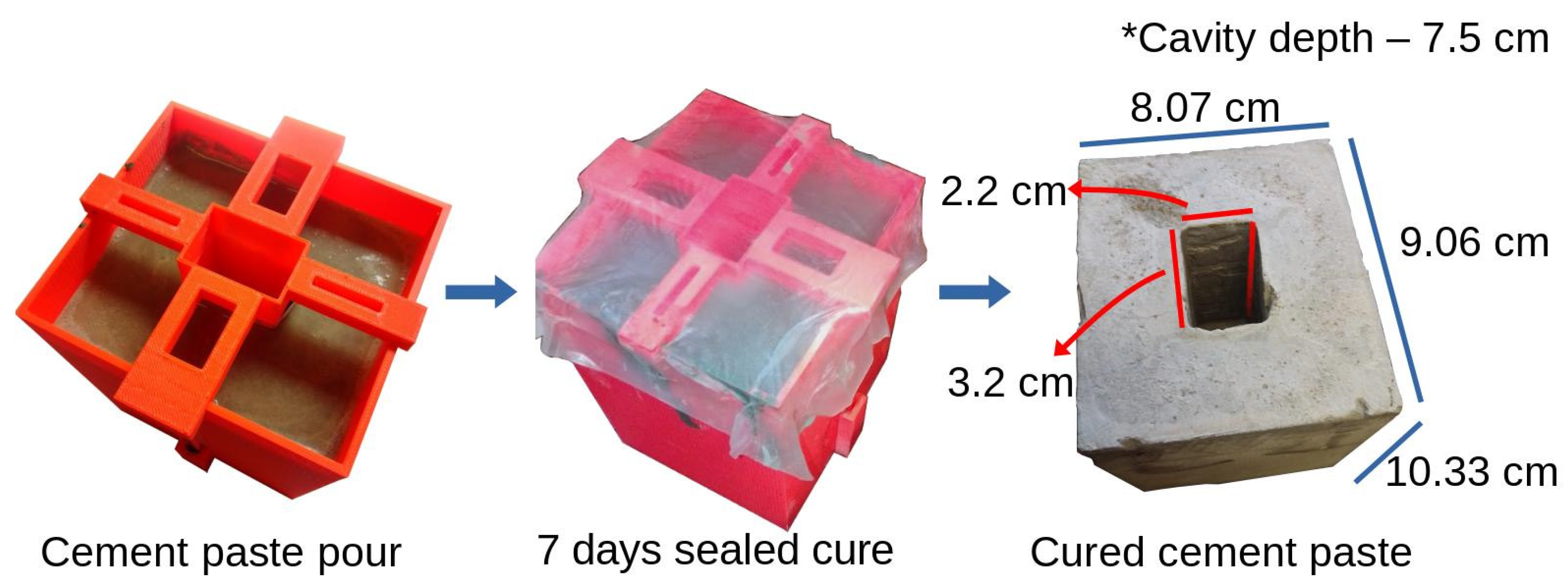
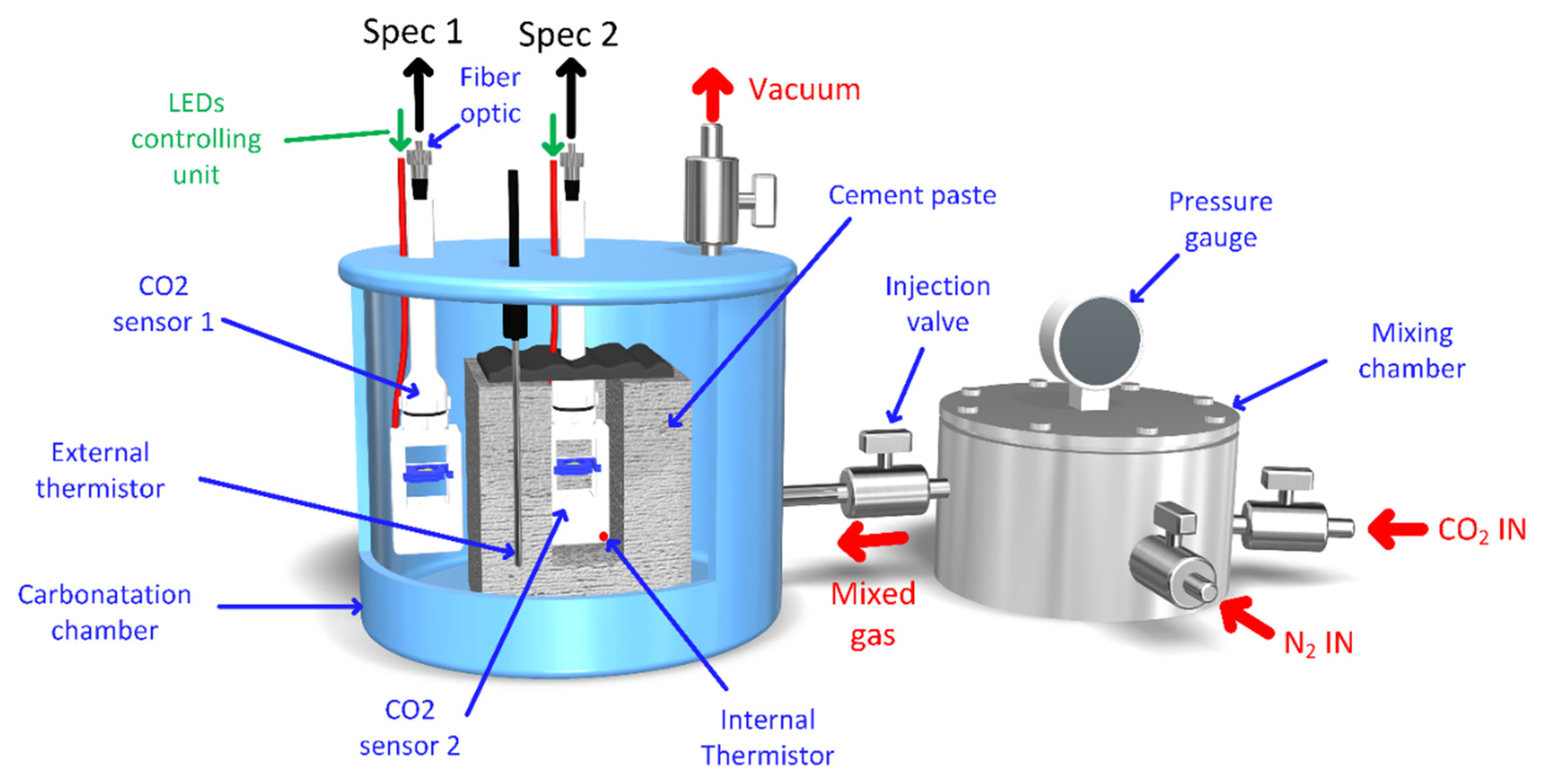

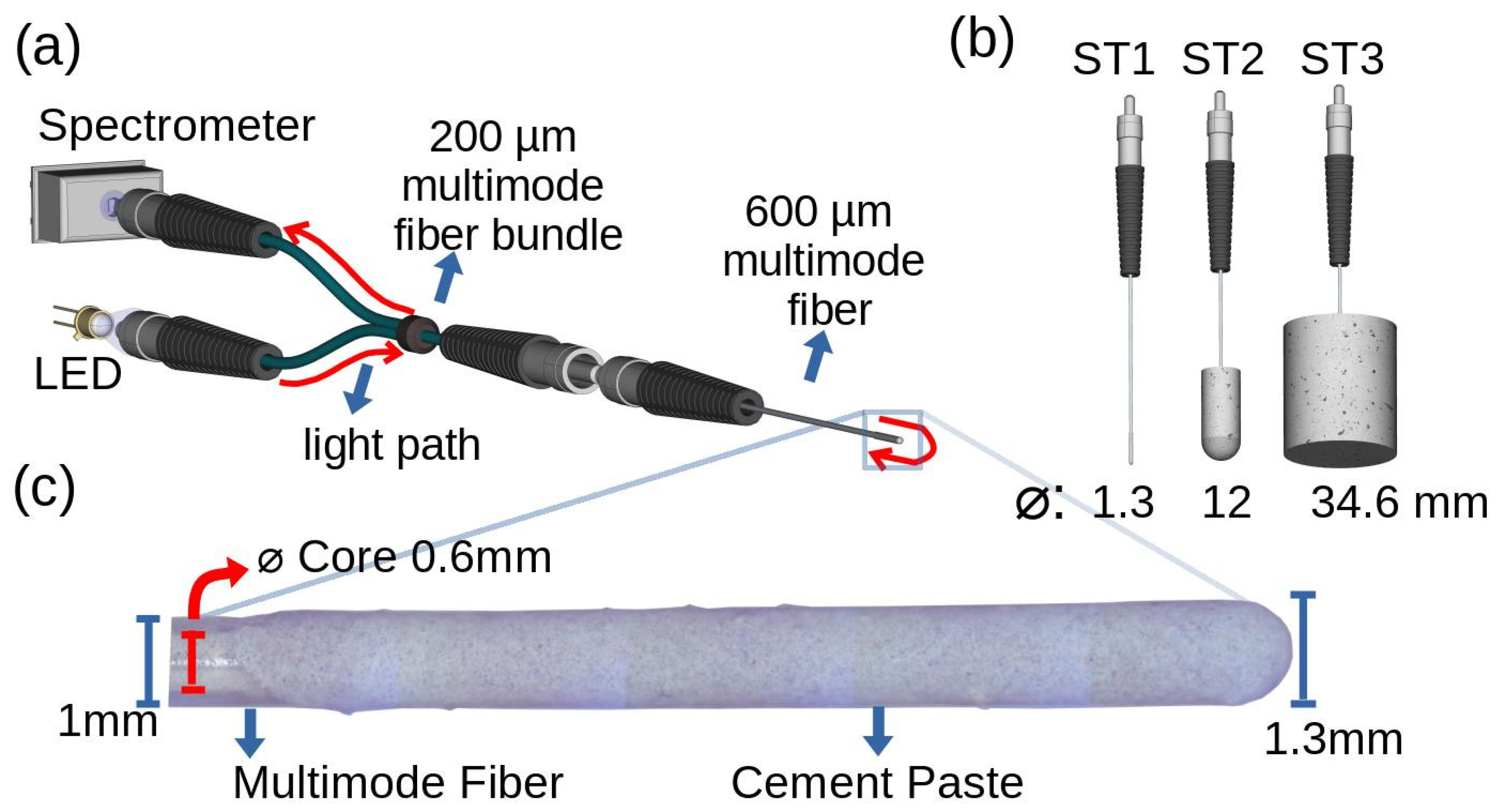
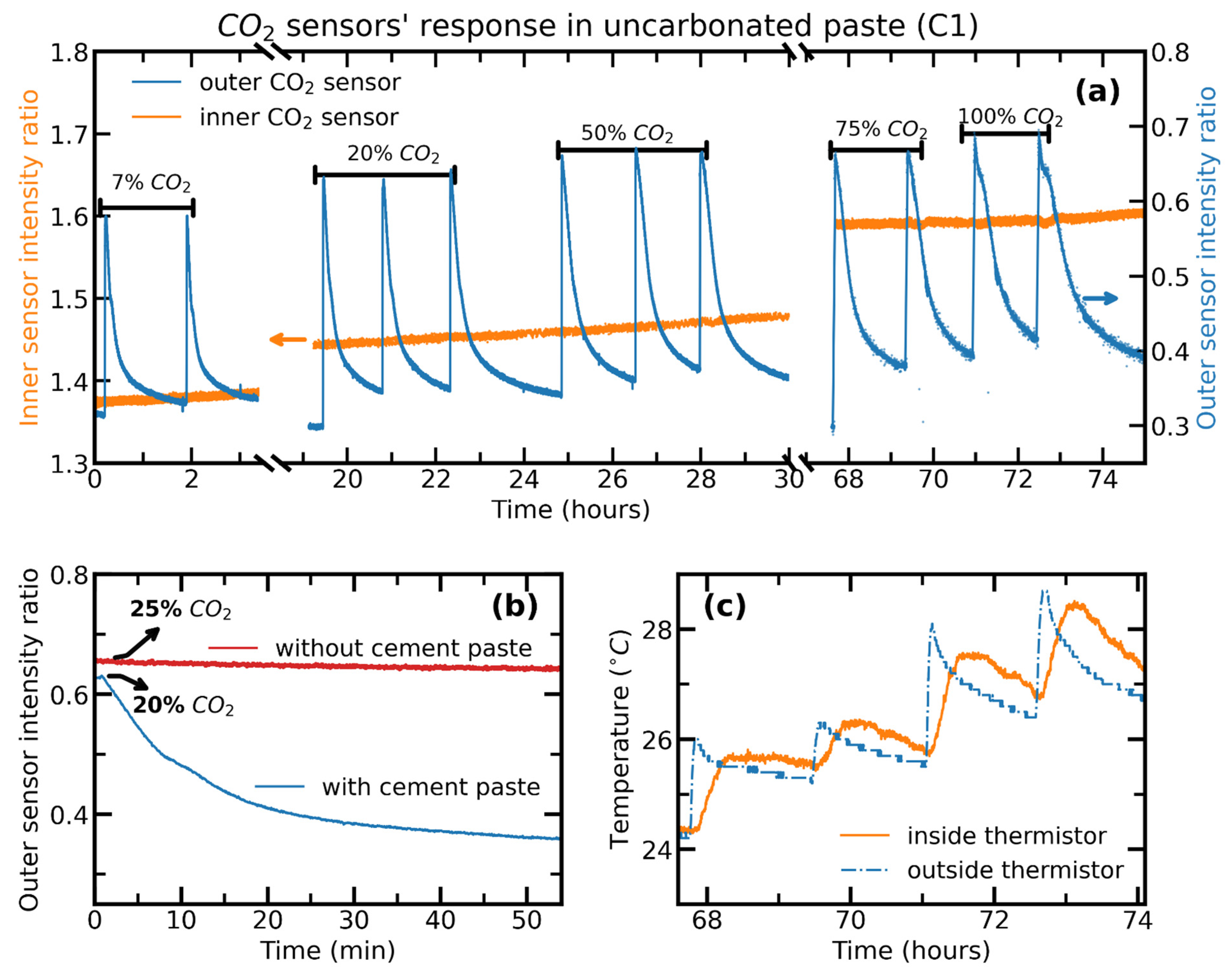
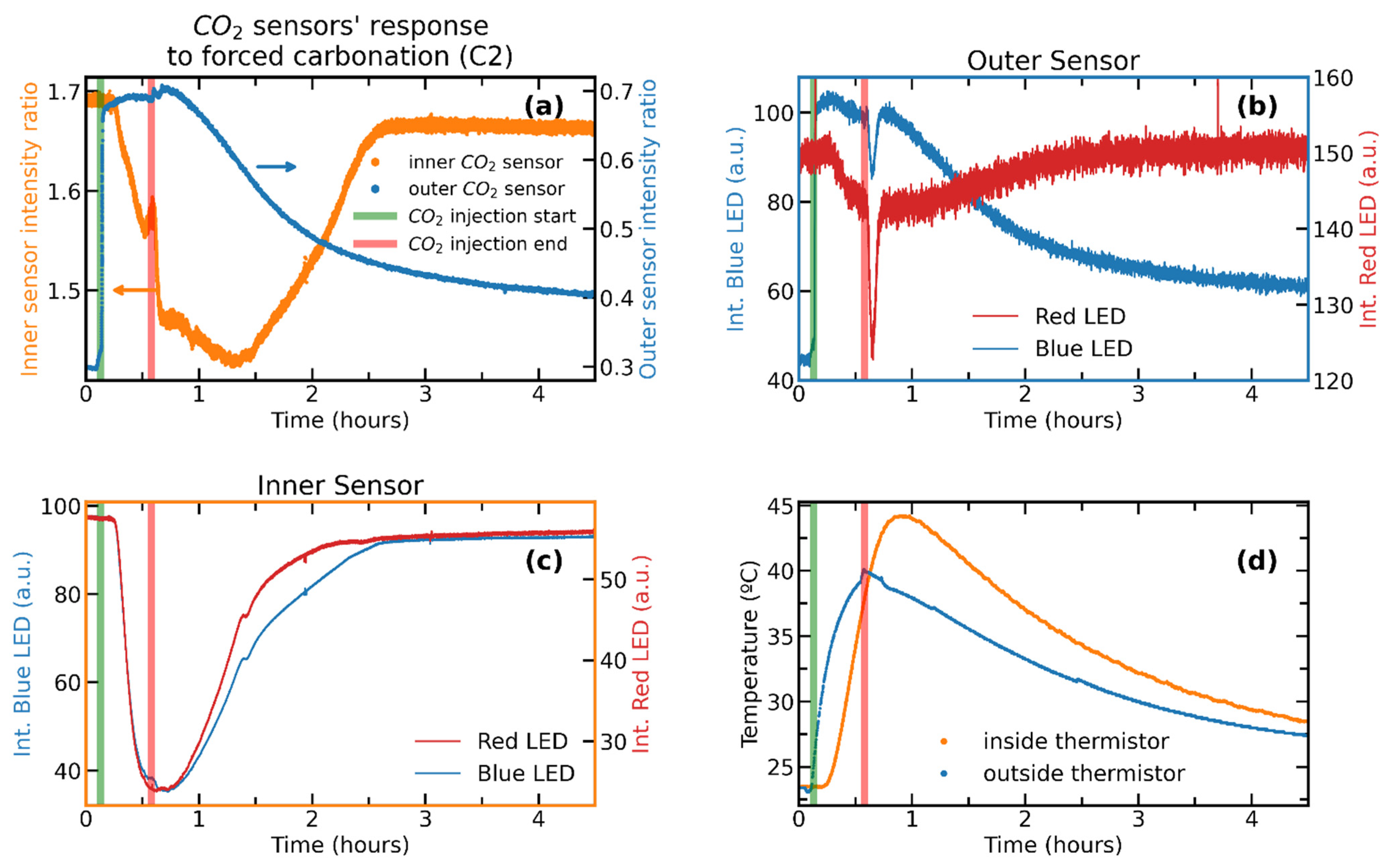
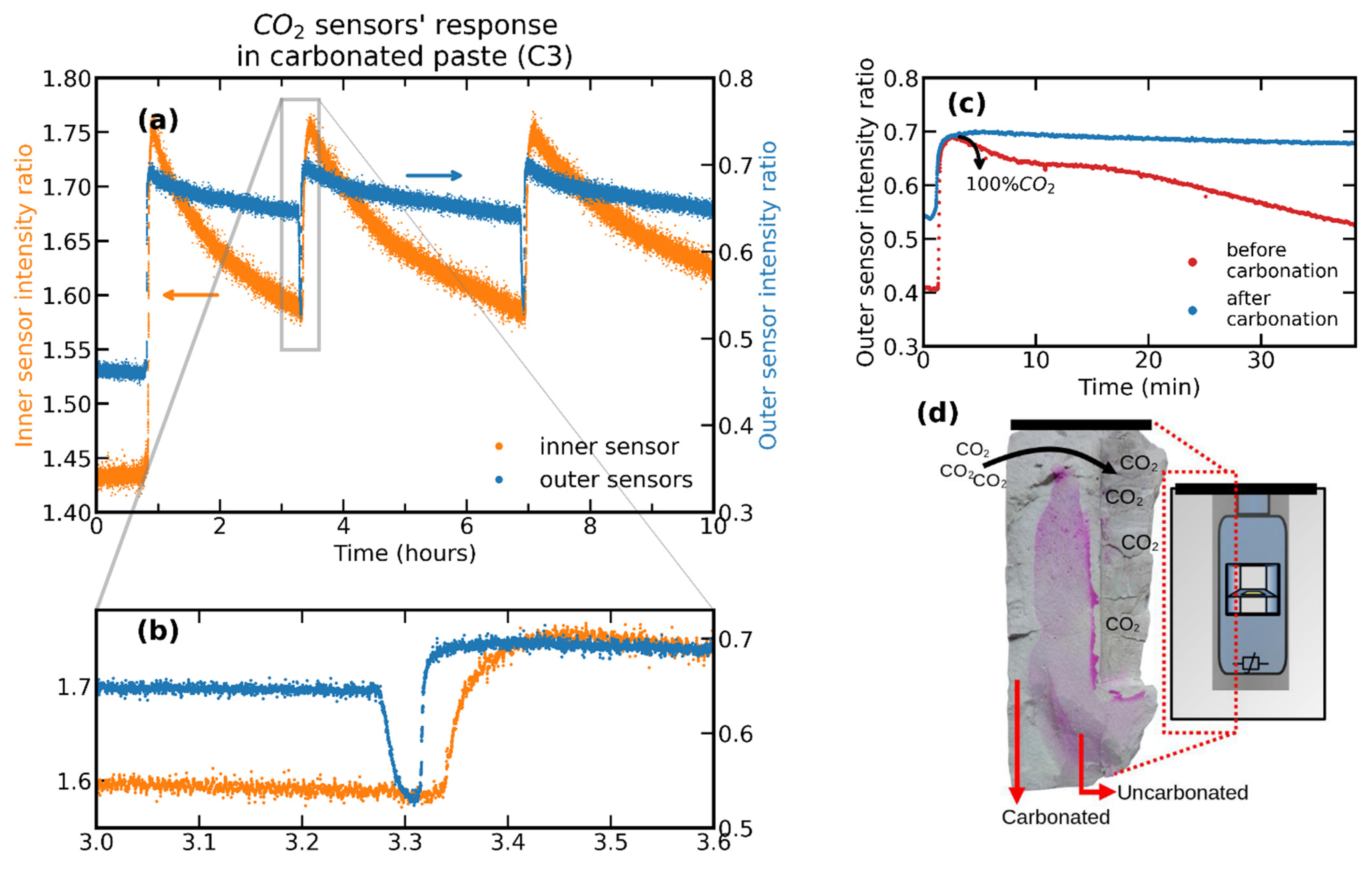
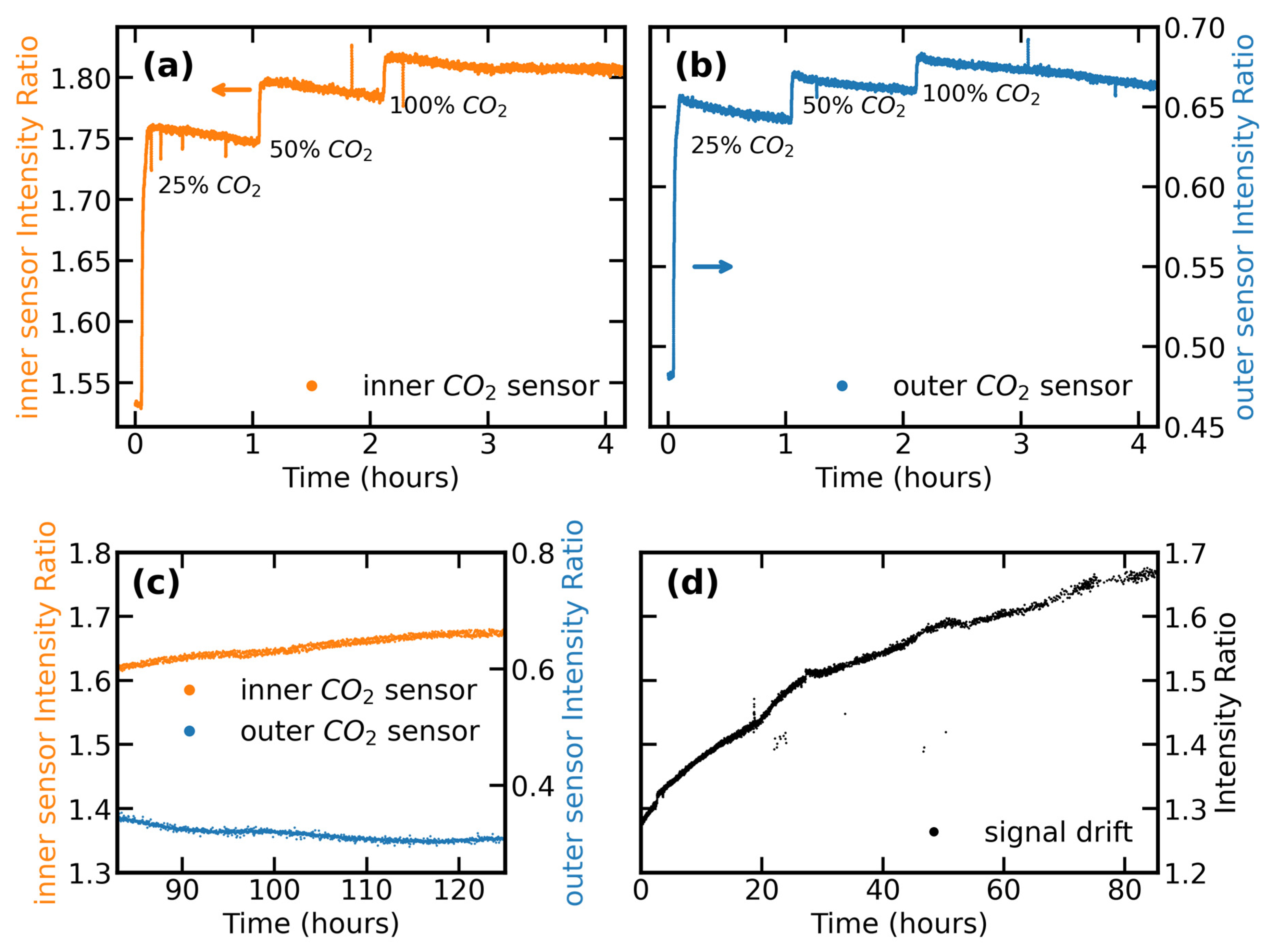

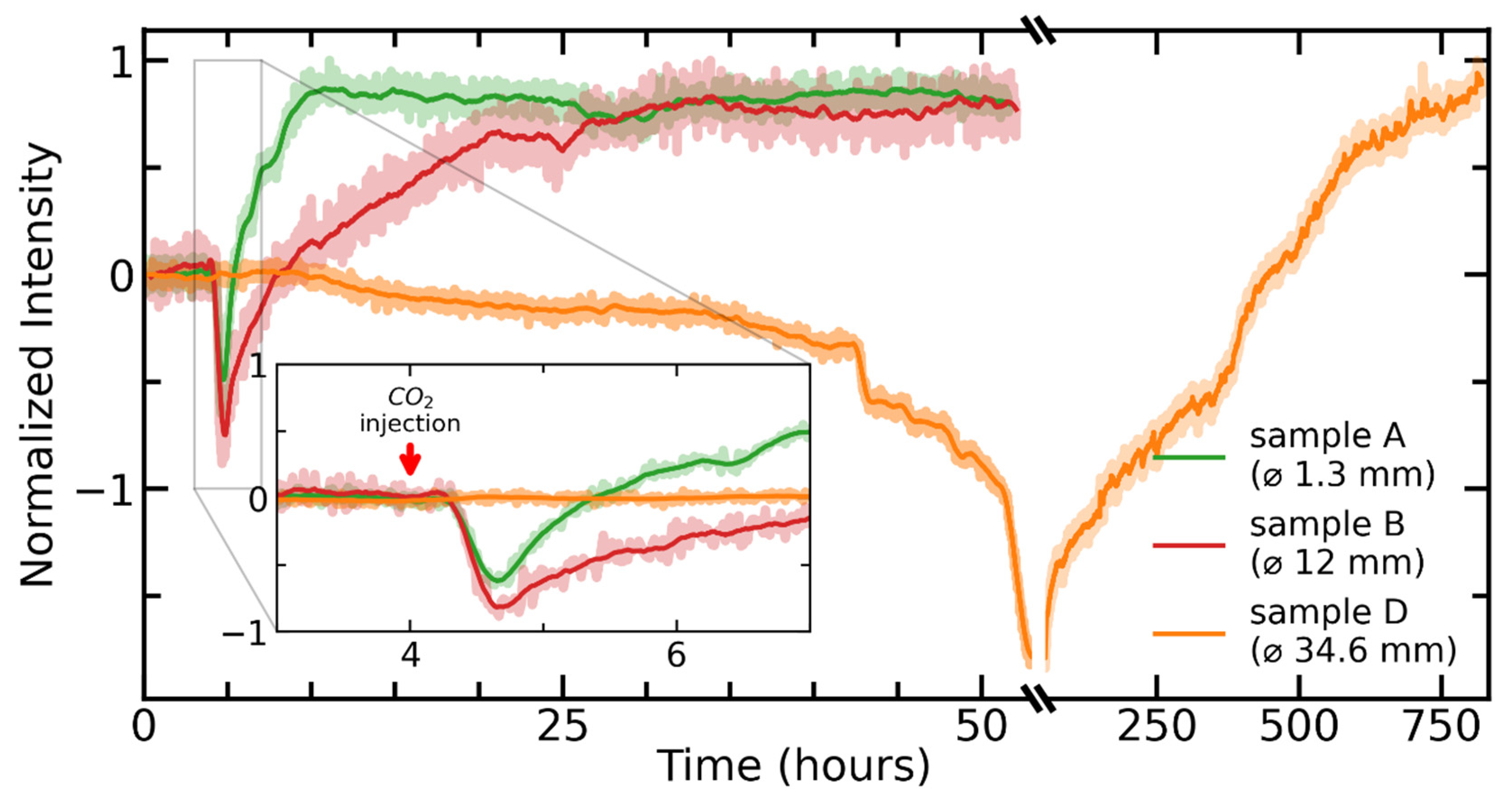
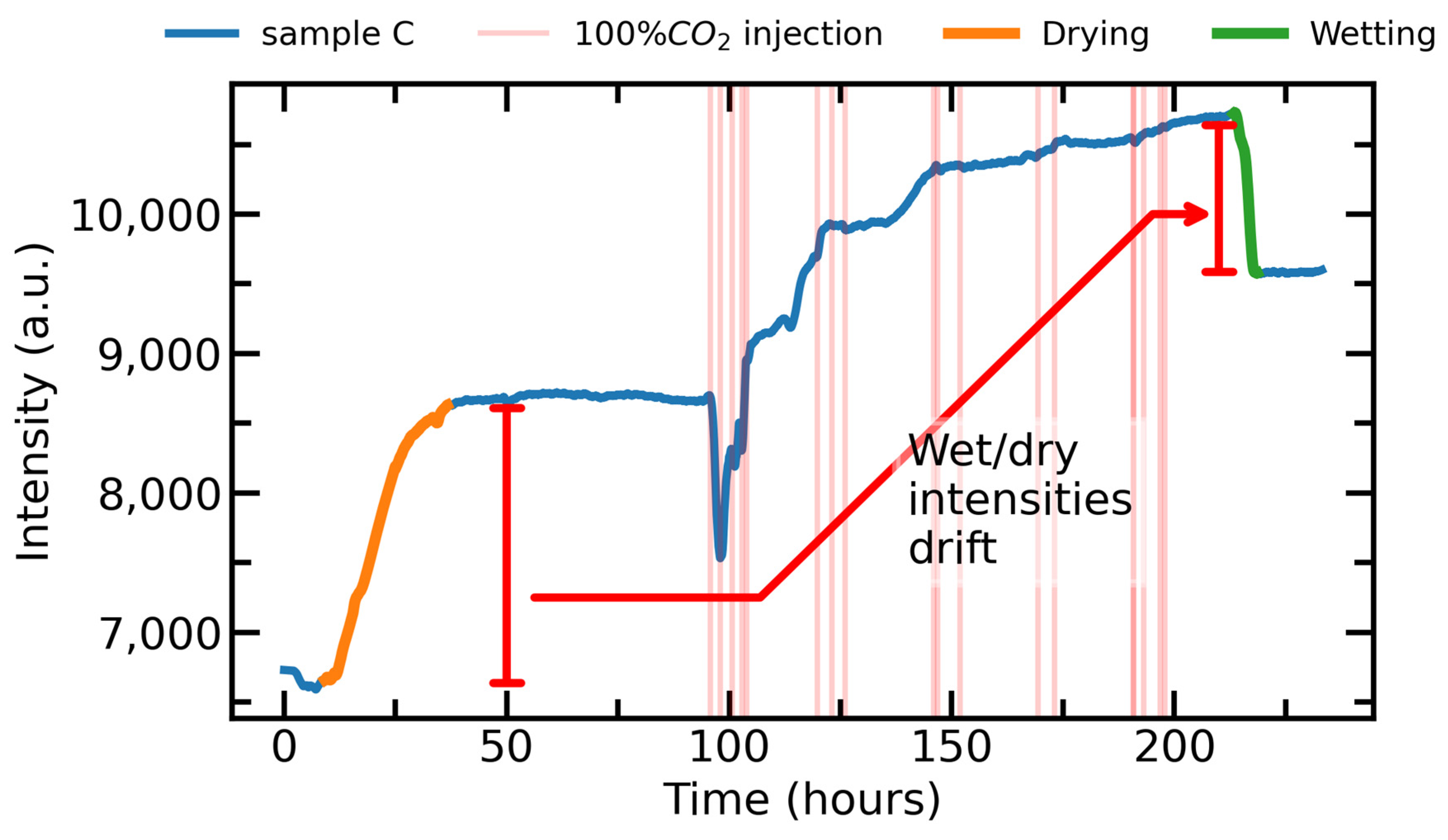
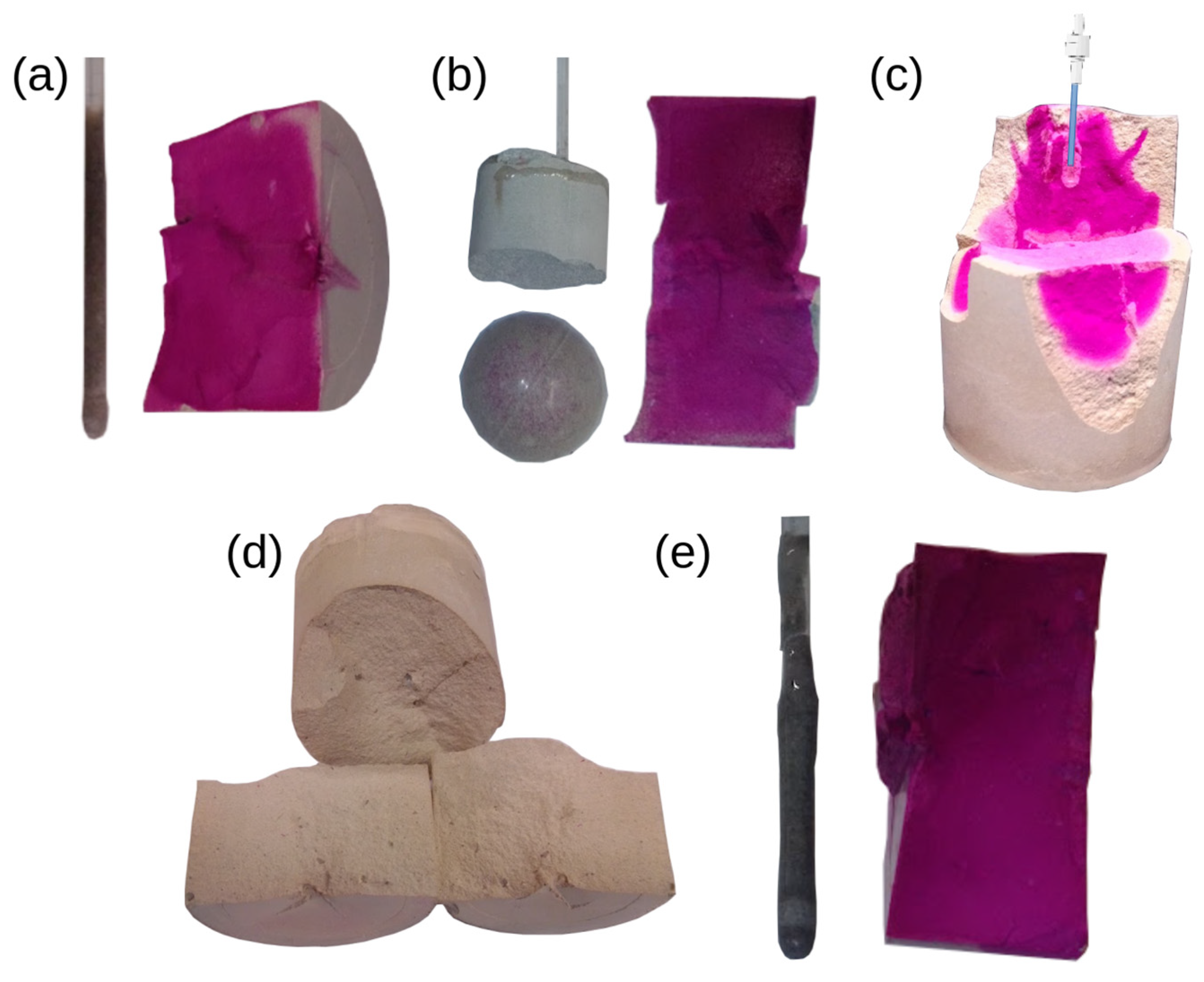
| Sets | Run Number | CO2 Concentration (%) | Injection Duration (min) | Time Since Last Injection (hours:min) | Repetition |
|---|---|---|---|---|---|
| C1 | 1 | 7 | 2 | 2 | |
| 2 | 20 | 17:43 | 3 | ||
| 3 | 50 | 2:32 | 3 | ||
| 4 | 75 | 15:39 | 2 | ||
| 5 | 100 | 1:30 | 2 | ||
| C2 | 6 | 100 | 27 | 64:07 | 1 |
| 7 | 45 | 169:40 | |||
| 8 | 22 | 21:07 | |||
| 9 | 52 | 2:42 | |||
| C3 | 10 | 100 | 5 | 16:52 | 3 |
| Sample Name | Sample Type | CO2 Concentration (%) | Volume Flow mL/min | Observation |
|---|---|---|---|---|
| A | ST1 | 100 | 300 | 60% RH |
| B | ST2 | 100 | 300 | 60% RH, sealed surface |
| C | ST3 | 100 | 300 | Unsealed surface |
| D | ST3 | 100 | 300 | Sealed Surface |
| E | ST1 | 3.2 | 310 | 60% RH |
| F | ST1 | 100 | 10 | 60% RH |
| Samples Reference | Carbonation Induced Signal Rise % | SNR |
|---|---|---|
| A | 1.6 | 19 |
| B | 4.4 | 9 |
| C | 18 | 55 |
| D | 3.8 | 22 |
| E | 12 | 39 |
| F | 5.6 | 13 |
Disclaimer/Publisher’s Note: The statements, opinions and data contained in all publications are solely those of the individual author(s) and contributor(s) and not of MDPI and/or the editor(s). MDPI and/or the editor(s) disclaim responsibility for any injury to people or property resulting from any ideas, methods, instructions or products referred to in the content. |
© 2023 by the authors. Licensee MDPI, Basel, Switzerland. This article is an open access article distributed under the terms and conditions of the Creative Commons Attribution (CC BY) license (https://creativecommons.org/licenses/by/4.0/).
Share and Cite
da Silva, P.M.; Mendes, J.P.; Coelho, L.C.C.; de Almeida, J.M.M.M. Real-Time Monitoring of Cement Paste Carbonation with In Situ Optical Fiber Sensors. Chemosensors 2023, 11, 449. https://doi.org/10.3390/chemosensors11080449
da Silva PM, Mendes JP, Coelho LCC, de Almeida JMMM. Real-Time Monitoring of Cement Paste Carbonation with In Situ Optical Fiber Sensors. Chemosensors. 2023; 11(8):449. https://doi.org/10.3390/chemosensors11080449
Chicago/Turabian Styleda Silva, Pedro M., João P. Mendes, Luís C. C. Coelho, and José M. M. M. de Almeida. 2023. "Real-Time Monitoring of Cement Paste Carbonation with In Situ Optical Fiber Sensors" Chemosensors 11, no. 8: 449. https://doi.org/10.3390/chemosensors11080449
APA Styleda Silva, P. M., Mendes, J. P., Coelho, L. C. C., & de Almeida, J. M. M. M. (2023). Real-Time Monitoring of Cement Paste Carbonation with In Situ Optical Fiber Sensors. Chemosensors, 11(8), 449. https://doi.org/10.3390/chemosensors11080449








